6.21.2023
The Cultural History of Godzilla – Pt 50
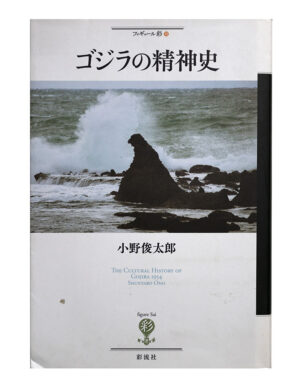
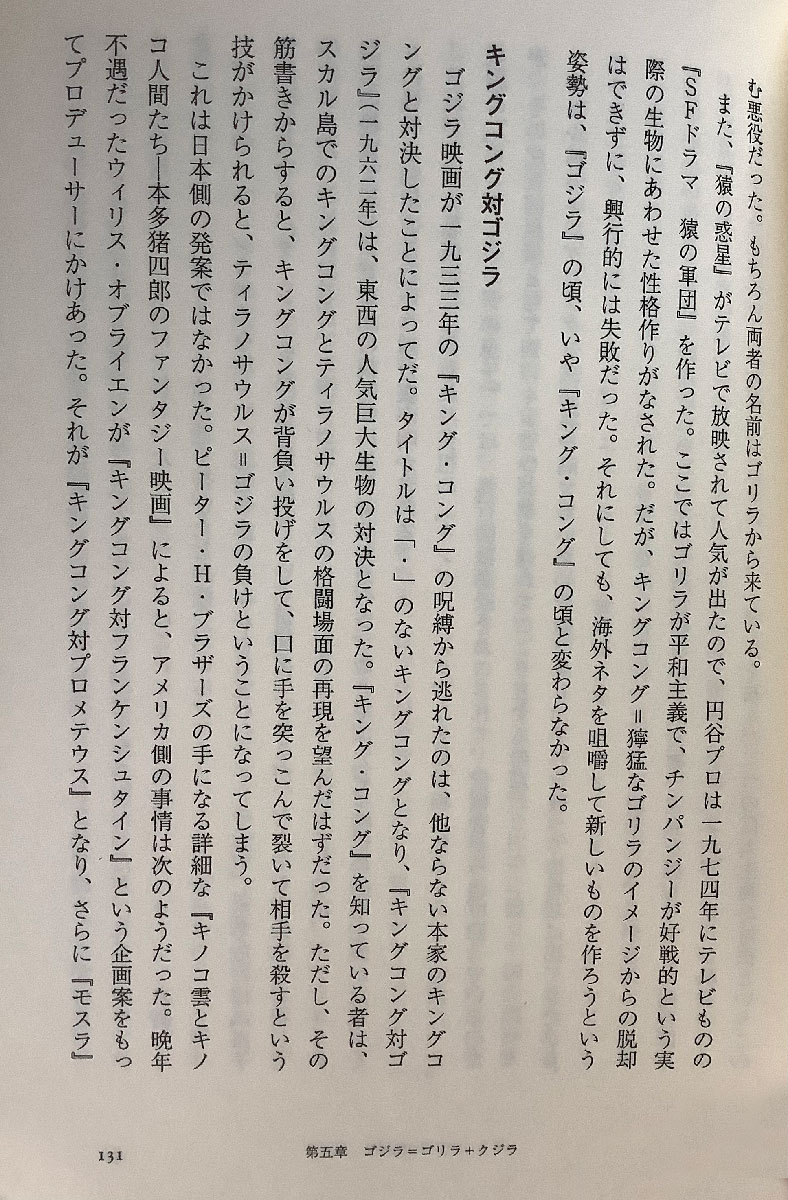
P 131b
キングコング対ゴジラ
King Kong vs Godzilla
ゴジラ映画が一九三三三年の『キング・コング』の呪縛から逃れたのは、他ならない本家のキングコングと対決したことによってだ。タイトルは「・」のないキングコングとなり、「キングコング対ゴジラ』(一九六二年)は、東西の人気巨大生物の対決となった。『キング・コング』を知っている者は、スカル島でのキングコングとティラノサウルスの格闘場面の再現を望んだはずだった。ただし、その筋書きからすると、キングコングが背負い投げをして、口に手を突っこんで裂いて相手を殺すという技がかけられると、ティラノサウルス=ゴジラの負けということになってしまう。
Godzilla movies escaped the spell of 1933’s “King Kong” by confronting none other than the original King Kong. The title became King Kong without the “・”, and “King Kong vs. Godzilla” (1962) became a showdown between popular giant creatures from the East and West. Those who knew “King Kong” would have wanted to reproduce the fighting scene between King Kong and Tyrannosaurus on Skull Island. However, according to the plot, if King Kong uses a shoulder throw and kills the opponent by sticking his hand in his mouth and tearing it apart, Tyrannosaurus = Godzilla will lose.
これは日本側の発案ではなかった。ピーター・H・ブラザーズの手になる詳細な『キノコ雲とキノコ人間たち―本多猪四郎のファンタジー映画』によると、アメリカ側の事情は次のようだった。晩年不遇だったウィリス・オブライエンが「キングコング対フランケンシュタイン」という企画案をもっプロデューサーにかけあった。それが『キングコング対プロメテウス』となり、さらに『モスラ』がアメリカで成功したのを受けて、実現可能なのは日本の東宝だということで持ちこんだ時点で、『キングコング対ゴジラ』となった。
This was not the Japanese idea. According to Peter H. Brothers’ detailed Mushroom Clouds and Mushroom People: Ishiro Honda’s Fantasy Film, the situation on the American side was as follows. Willis O’Brien, who had been unlucky in his later years, approached the producer with a proposal for “King Kong vs. Frankenstein.” That became “King Kong vs. Prometheus,” and after “Mothra” was successful in the United States, it became “King Kong vs. Godzilla” when it was brought to Japan’s Toho.
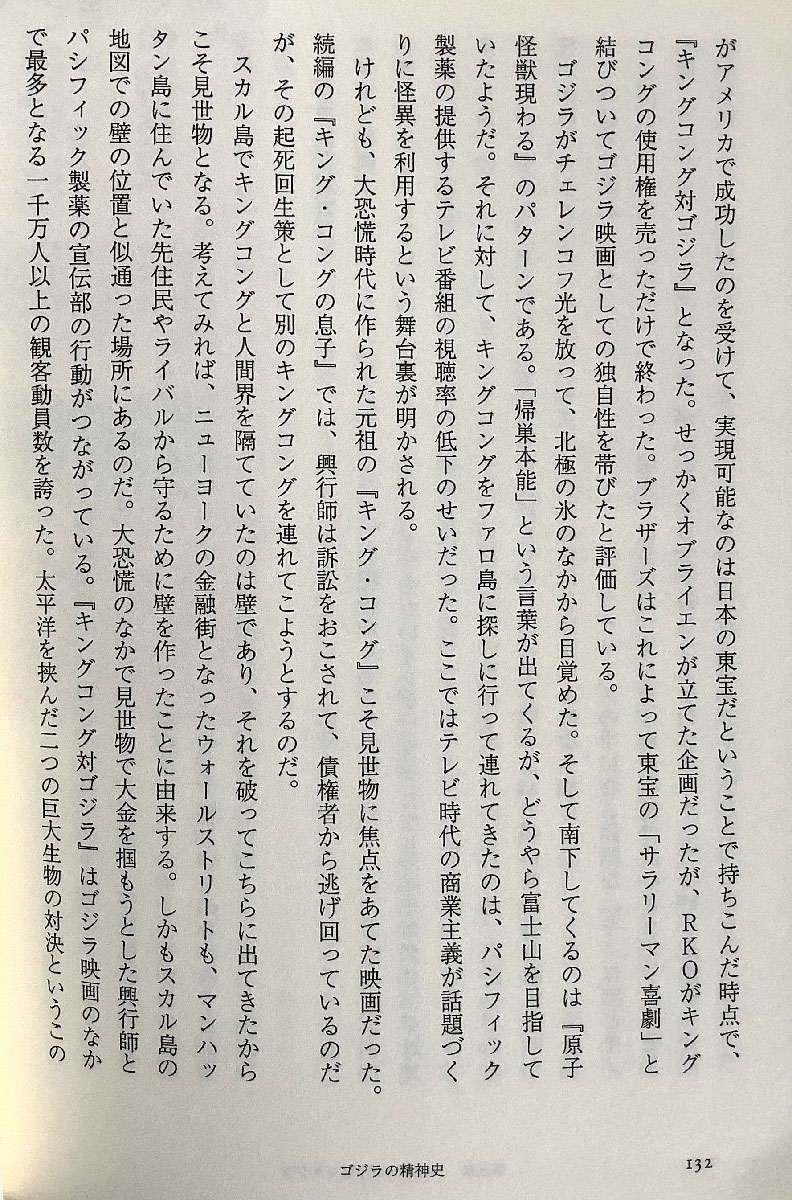
P 132
せっかくオブライエンが立てた企画だったが、RKOがキングコングの使用権を売っただけで終わった。ブラザーズはこれによって東宝の「サラリーマン喜劇」と結びついてゴジラ映画としての独自性を帯びたと評価している。
It was a project that O’Brien put up, but it ended with RKO selling the right to use King Kong. Brothers evaluate that this is connected with Toho’s “office worker comedy” and has given it a uniqueness as a Godzilla movie.
ゴジラがチェレンコフ光を放って、北極の氷のなかから目覚めた。そして南下してくるのは『原子怪獣現わる』のパターンである。「帰巣本能」という言葉が出てくるが、どうやら富士山を目指していたようだ。それに対して、キングコングをファロ島に探しに行って連れてきたのは、パシフィック製薬の提供するテレビ番組の視聴率の低下のせいだった。ここではテレビ時代の商業主義が話題づくりに怪異を利用するという舞台裏が明かされる。
Godzilla emits a Cherenkov light and wakes up from the Arctic ice. And it is the pattern of “The Beast from 20,000 Fathoms” that goes south. The word “homing instinct” comes out, but it seems that he was aiming for Mt. Fuji. On the other hand, it was because of the declining ratings of the television program provided by Pacific Pharmaceuticals that he went looking for King Kong and brought him to Faro Island. Here is a behind-the-scenes look at how commercialism in the television age uses ghosts to create stories.
けれども、大恐慌時代に作られた元祖の『キング・コング』こそ見世物に焦点をあてた映画だった。続編の『キング・コングの息子』では、興行師は訴訟をおこされて、債権者から逃げ回っているのだが、その起死回生策として別のキングコングを連れてこようとするのだ。
But the original Depression-era King Kong was a spectacle-focused movie. In the sequel, “Son of Kong,” the impresario is sued and on the run from his creditors, but he tries to bring in another King Kong as a way to turn things around.
スカル島でキングコングと人間界を隔てていたのは壁であり、それを破ってこちらに出てきたからこそ見世物となる。考えてみれば、ニューヨークの金融街となったウォールストリートも、マンハッタン島に住んでいた先住民やライバルから守るために壁を作ったことに由来する。しかもスカル島の地図での壁の位置と似通った場所にあるのだ。大恐慌のなかで見世物で大金を掴もうとした興行師とパシフィック製薬の宣伝部の行動がつながっている。『キングコング対ゴジラ』はゴジラ映画のなかで最多となる一千万人以上の観客動員数を誇った。太平洋を挟んだ二つの巨大生物の対決というこの映画そのものが見世物として成功したのだ。
On Skull Island, King Kong was separated from the human world by a wall. Come to think of it, Wall Street, which became New York’s financial district, also originated from the fact that the wall was built to protect it from the indigenous people who lived on Manhattan Island and their rivals. Moreover, it is in a place similar to the location of the wall on the map of Skull Island. There is a connection between the actions of a showman who tried to grab a lot of money at a show during the Great Depression and the advertising department of Pacific Pharmaceuticals. “King Kong vs. Godzilla” boasted over 10 million viewers, the most among Godzilla movies. The film itself, a confrontation between two giant creatures across the Pacific Ocean, was a successful spectacle.
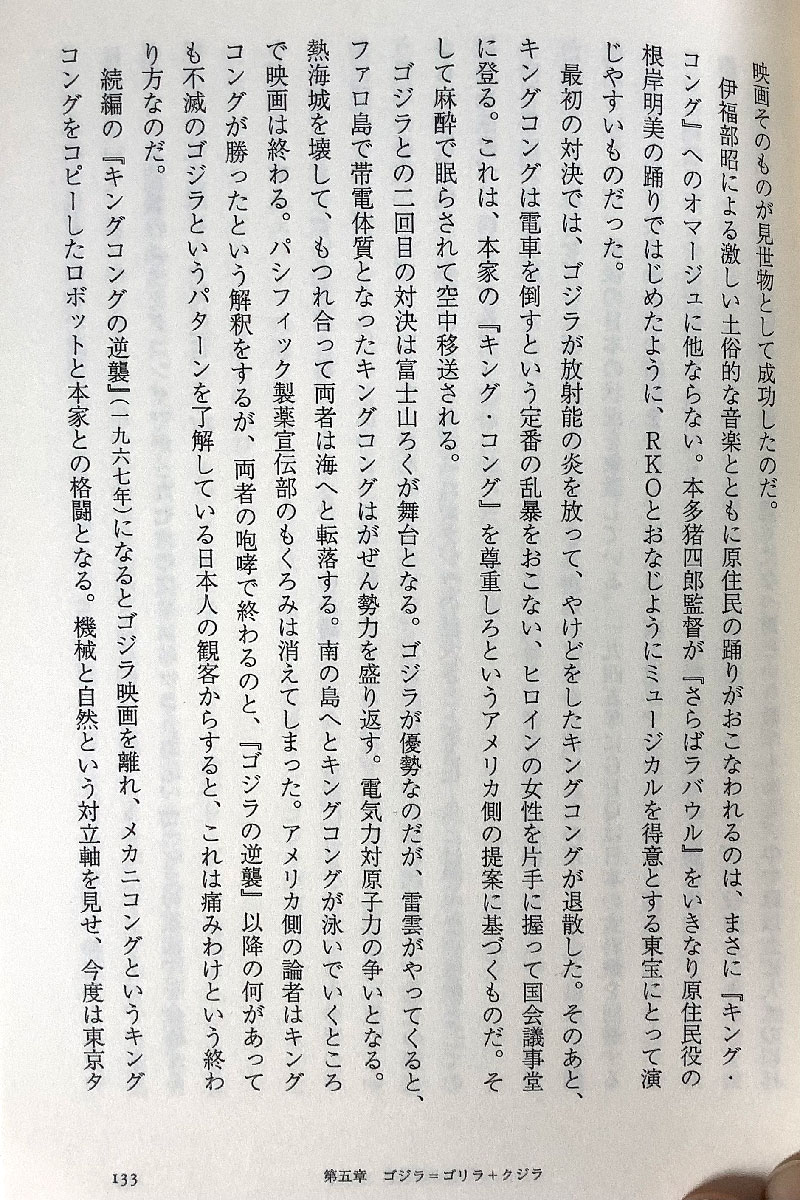
P 133
伊福部昭による激しい土俗的な音楽とともに原住民の踊りがおこなわれるのは、まさに『キング・コング』へのオマージュに他ならない。本多猪四郎監督が『さらばラバウル』をいきなり原住民役の根岸明美の踊りではじめたように、RKOとおなじようにミュージカルを得意とする東宝にとって演じやすいものだった。
The aboriginal dances accompanied by the intense folk music by Akira Ifukube is nothing less than an homage to “King Kong.” Just like director Ishiro Honda’s “Farewell Rabaul” suddenly started with Akemi Negishi dancing as the native, it was easy to perform for Toho, who is as good at musicals as RKO.
最初の対決では、ゴジラが放射能の炎を放って、やけどをしたキングコングが退散した。そのあと、キングコングは電車を倒すという定番の乱暴をおこない、ヒロインの女性を片手に握って国会議事堂に登る。これは、本家の『キング・コング』を尊重しろというアメリカ側の提案に基づくものだ。そして麻酔で眠らされて空中移送される。
In the first showdown, Godzilla unleashes a radioactive flame that burns King Kong away. After that, King Kong does his classic act of knocking over a train, grabbing the female heroine in one hand and climbs the Houses of Parliament. This is based on the American side’s proposal to respect the original “King Kong.” Then, they are put to sleep by anesthesia and transported in the air.
ゴジラとの二回目の対決は富士山ろくが舞台となる。ゴジラが優勢なのだが、雷雲がやってくると、ファロ島で帯電体質となったキングコングはがぜん勢力を盛り返す。電気力対原子力の争いとなる。熱海城を壊して、もつれ合って両者は海へと転落する。南の島へとキングコングが泳いでいくところで映画は終わる。パシフィック製薬宣伝部のもくろみは消えてしまった。アメリカ側の論者はキングコングが勝ったという解釈をするが、両者の咆哮で終わるのと、『ゴジラの逆襲』以降の何があっても不滅のゴジラというパターンを了解している日本人の観客からすると、これは痛みわけという終わり方なのだ。
The second showdown with Godzilla takes place at the foot of Mt. Fuji. Godzilla has the upper hand, but when a thundercloud comes, King Kong, who has become electrified on Faro Island, regains power. It becomes a battle between electric power and nuclear power. Destroying Atami Castle, they tangle and both fall into the sea. The movie ends with King Kong swimming to a southern island. The plan of the Pacific Pharmaceuticals propaganda department has disappeared. The American commentators interpret that King Kong won, but the Japanese audience understands the pattern of ending with both roars and the immortal Godzilla no matter what happens after “Godzilla Raids Again.” From that point of view, this is a painful ending.
続編の『キングコングの逆襲』(一九六七年)になるとゴジラ映画を離れ、メカニコングというキングコングをコピーしたロボットと本家との格闘となる。機械と自然という対立軸を見せ、今度は東京タワーで本物と偽者の両者が激突する。
In the sequel “King Kong Escapes” (1967), it departs from the Godzilla movie and becomes a battle between the robot called Mechani Kong, which is a copy of King Kong, and the original family. Showing the axis of confrontation between machine and nature, this time the real and fake clash at Tokyo Tower.
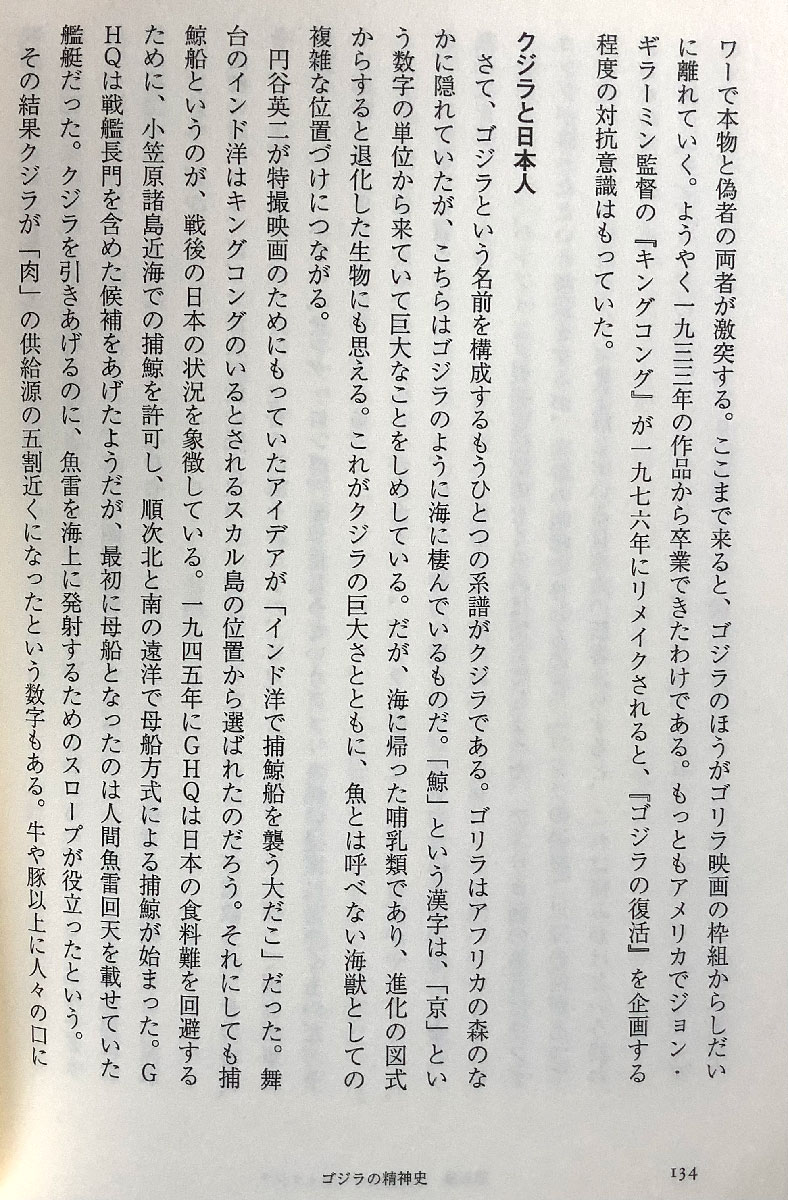
P 134
ここまで来ると、ゴジラのほうがゴリラ映画の枠組からしだいに離れていく。ようやく一九三三年の作品から卒業できたわけである。もっともアメリカでジョン・ギラーミン監督の『キングコング』が一九七六年にリメイクされると、『ゴジラの復活』を企画する程度の対抗意識はもっていた。
At this point, Godzilla gradually moves away from the gorilla movie framework. He was finally able to graduate from the work of 1933. However, when John Guillermin’s “King Kong” was remade in the United States in 1976, he had a sense of rivalry to the extent that he planned “Resurrection of Godzilla.”
円谷英二が特撮映画のためにもっていたアイデアが「インド洋で捕鯨船を襲う大だこ」だった。舞台のインド洋はキングコングのいるとされるスカル島の位置から選ばれたのだろう。それにしても捕鯨船というのが、戦後の日本の状況を象徴している。一九四五年にGHQは日本の食料難を回避するために、小笠原諸島近海での捕鯨を許可し、順次北と南の遠洋で母船方式による捕鯨が始まった。GHQは戦艦長門を含めた候補をあげたようだが、最初に母船となったのは人間魚雷回天を載せていた艦艇だった。クジラを引きあげるのに、魚雷を海上に発射するためのスロープが役立ったという。その結果クジラが「肉」の供給源の五割近くになったという数字もある。牛や豚以上に人々の口に入っていた時期があったのだ。
The idea that Eiji Tsuburaya had for a special effects movie was “A giant octopus attacking a whaling ship in the Indian Ocean.” The setting, the Indian Ocean, was probably chosen because of the location of Skull Island, where King Kong is said to be. Even so, the whaling ship symbolizes the postwar situation in Japan. In 1945, in order to avoid Japan’s food shortage, GHQ permitted whaling in the waters near the Ogasawara Islands, and whaling by the mothership method began in the northern and southern oceans. GHQ seems to have given candidates including the battleship Nagato, but the first mother ship was a ship carrying a human torpedo Kaiten [human torpedo in WW2]. A ramp for launching torpedoes into the sea was helpful in pulling the whale up. As a result, there is a figure that whales have become nearly 50% of the supply source of “meat.” There was a time when it was in people’s mouths more than cows and pigs.